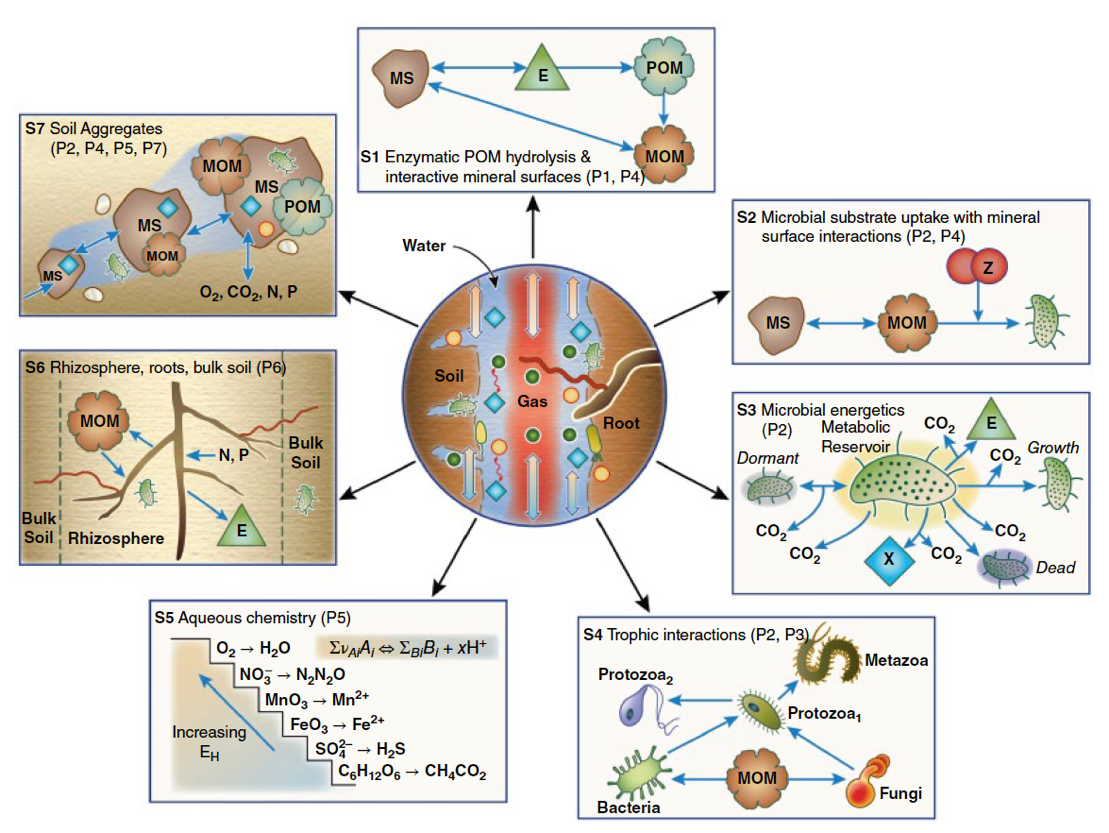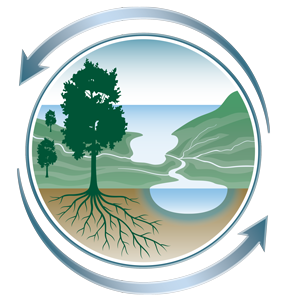March 01, 2022
Next-Generation Soil Biogeochemistry Model Representations
New proposed community open-source model farm (BeTR-S) will facilitate mechanistic modeling of soil biogeochemistry.

Seven soil biogeochemical network subunits connect seven classes of processes via transport and substrate competition. Acronym key: mineral surface (MS), monomeric organic molecule (MOM), enzyme (E), polymeric organic molecule (POM), microbial exudate (X), and complementary substrate (Z).
[Reprinted with permission from Riley, W.J., et al. “Next Generation Soil Biogeochemistry Model Representations: A Proposed Community Open-Source Model Farm (BeTR-S).” In: Multi-Scale Biogeochemical Processes in Soil Ecosystems: Critical Reactions and Resilience to Climate Changes, 233–57 (2022). John Wiley & Sons, Inc: New York. © 2022 John Wiley & Sons Ltd.]
The Science
Soils contain Earth’s largest actively cycling carbon (C) stocks and currently store at least several times the amount of carbon (as CO2) in the atmosphere. Yet, model predictions are highly uncertain. Therefore, improving model structures and availability of open-source platforms is imperative. This study (1) reviews seven dominant classes of soil biogeochemical processes affecting soil organic matter stability, (2) describes the open-source framework called Biogeochemical Transport and Reaction for Soils (BeTR-S) that can be applied to simulate these dynamics, and (3) discusses its application at a field site in Blodgett, California.
The Impact
Soil carbon (C) dynamics affect atmospheric CO2 levels, but these dynamics are uncertain in numerical models used for climate change analyses. This study contends that an important source of that uncertainty is the current lack of mechanistic representation of dominant processes in land models. This study first reviews seven important classes of biogeochemical processes affecting soil C. It goes on to describe the open-source reactive transport solver BeTR-S, which can be used to explore hypotheses of how these processes should be represented. Finally, the study discusses how BeTR-S was applied to a research team’s field warming manipulation at Blodgett, California.
Summary
Substantial uncertainty exists in site- to global-scale assessments of soil organic matter cycling. Current site- to global-scale land models have very simple representations of soil organic matter cycling, likely contributing to this uncertainty. This study describes seven dominant classes of soil biogeochemical processes that affect soil organic matter dynamics (see figure): (P1) litter input and polymeric SOM degradation; (P2) microbial physiology, microbial population dynamics, and macronutrient controls; (P3) trophic interactions; (P4) mineral–organic interactions; (P5) soil redox and pH chemistry; (P6) rhizosphere-bulk soil interactions; and (P7) soil structure dynamics. It then describes how these processes can be numerically represented and simulated in a vertically-resolved, open-source package called BeTR-S. Finally, this study discusses how BeTR-S was applied to evaluate the effects of warming on soil C at a field site Blodgett, California.
Principal Investigator
William J. Riley
Lawrence Berkeley National Laboratory
[email protected]
Co-Principal Investigator
Margaret Torn
Lawrence Berkeley National Laboratory
[email protected]
Program Manager
Daniel Stover
U.S. Department of Energy, Biological and Environmental Research (SC-33)
Environmental System Science
[email protected]
Funding
This research was supported by the Biological and Environmental Research (BER) Program within the U.S. Department of Energy’s (DOE) Office of Science to Lawrence Berkeley National Laboratory (LBNL) as part of the Belowground Biogeochemistry Scientific Focus Area.
Related Links
References
Riley, W.J., et al. "Next Generation Soil Biogeochemistry Model Representations: A Proposed Community Open Source Model Farm (BeTR-S)". In: Multi-Scale Biogeochemical Processes in Soil Ecosystems: Critical Reactions and Resilience to Climate Changes, 233–57. 2022. John Wiley & Sons, Inc, New York

